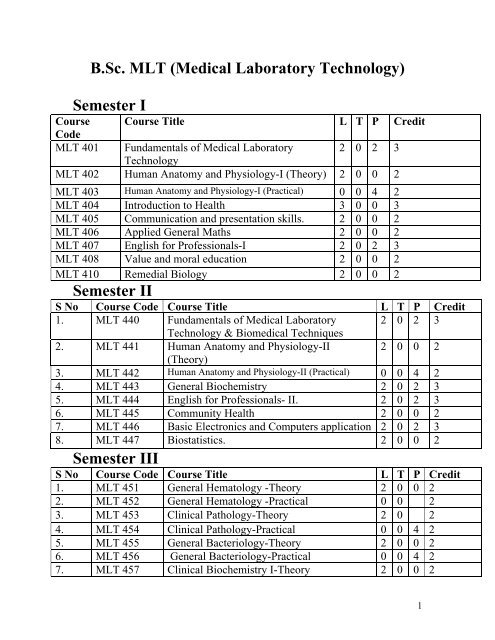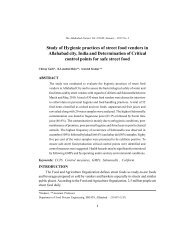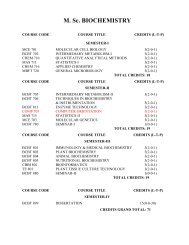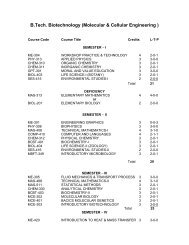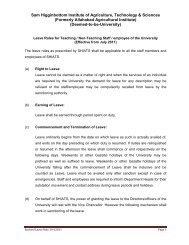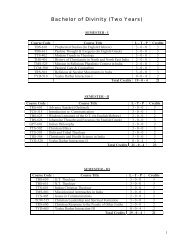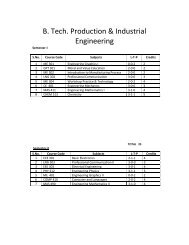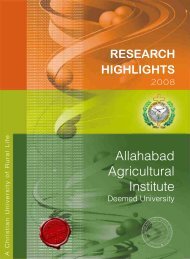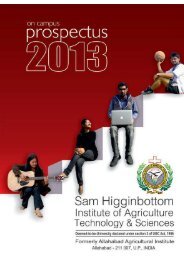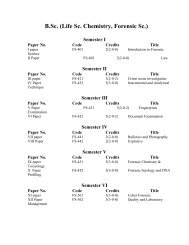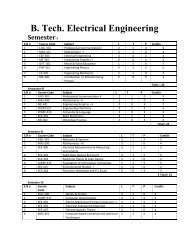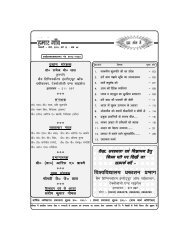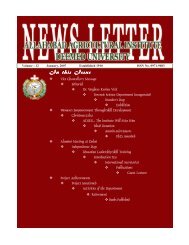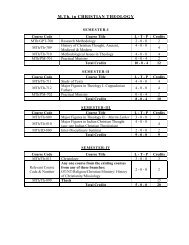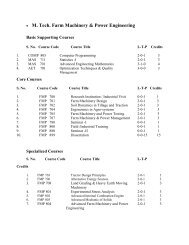B.Sc. MLT (Medical Laboratory Technology ... - Shiats.edu.in
B.Sc. MLT (Medical Laboratory Technology ... - Shiats.edu.in
B.Sc. MLT (Medical Laboratory Technology ... - Shiats.edu.in
You also want an ePaper? Increase the reach of your titles
YUMPU automatically turns print PDFs into web optimized ePapers that Google loves.
B.<strong>Sc</strong>. <strong>MLT</strong> (<strong>Medical</strong> <strong>Laboratory</strong> <strong>Technology</strong>)<br />
Semester I<br />
Course Course Title L T P Credit<br />
Code<br />
<strong>MLT</strong> 401 Fundamentals of <strong>Medical</strong> <strong>Laboratory</strong> 2 0 2 3<br />
<strong>Technology</strong><br />
<strong>MLT</strong> 402 Human Anatomy and Physiology-I (Theory) 2 0 0 2<br />
<strong>MLT</strong> 403 Human Anatomy and Physiology-I (Practical) 0 0 4 2<br />
<strong>MLT</strong> 404 Introduction to Health 3 0 0 3<br />
<strong>MLT</strong> 405 Communication and presentation skills. 2 0 0 2<br />
<strong>MLT</strong> 406 Applied General Maths 2 0 0 2<br />
<strong>MLT</strong> 407 English for Professionals-I 2 0 2 3<br />
<strong>MLT</strong> 408 Value and moral <strong>edu</strong>cation 2 0 0 2<br />
<strong>MLT</strong> 410 Remedial Biology 2 0 0 2<br />
Semester II<br />
S No Course Code Course Title L T P Credit<br />
1. <strong>MLT</strong> 440 Fundamentals of <strong>Medical</strong> <strong>Laboratory</strong> 2 0 2 3<br />
<strong>Technology</strong> & Biomedical Techniques<br />
2. <strong>MLT</strong> 441 Human Anatomy and Physiology-II<br />
(Theory)<br />
2 0 0 2<br />
3. <strong>MLT</strong> 442 Human Anatomy and Physiology-II (Practical) 0 0 4 2<br />
4. <strong>MLT</strong> 443 General Biochemistry 2 0 2 3<br />
5. <strong>MLT</strong> 444 English for Professionals- II. 2 0 2 3<br />
6. <strong>MLT</strong> 445 Community Health 2 0 0 2<br />
7. <strong>MLT</strong> 446 Basic Electronics and Computers application 2 0 2 3<br />
8. <strong>MLT</strong> 447 Biostatistics. 2 0 0 2<br />
Semester III<br />
S No Course Code Course Title L T P Credit<br />
1. <strong>MLT</strong> 451 General Hematology -Theory 2 0 0 2<br />
2. <strong>MLT</strong> 452 General Hematology -Practical 0 0 2<br />
3. <strong>MLT</strong> 453 Cl<strong>in</strong>ical Pathology-Theory 2 0 2<br />
4. <strong>MLT</strong> 454 Cl<strong>in</strong>ical Pathology-Practical 0 0 4 2<br />
5. <strong>MLT</strong> 455 General Bacteriology-Theory 2 0 0 2<br />
6. <strong>MLT</strong> 456 General Bacteriology-Practical 0 0 4 2<br />
7. <strong>MLT</strong> 457 Cl<strong>in</strong>ical Biochemistry I-Theory 2 0 0 2<br />
1
8. <strong>MLT</strong> 458 Cl<strong>in</strong>ical Biochemistry I-Practical 0 0 4 2<br />
9. <strong>MLT</strong> 459 Biostatistics 2 0 0 2<br />
10. SCS 415 Environmental <strong>Sc</strong>iences-I 2 0 0 2<br />
Semester IV<br />
S No Course Course Title L T P Credit<br />
Code<br />
1. <strong>MLT</strong> 501 Cl<strong>in</strong>ical Biochemistry II -Theory 2 0 0 2<br />
2. <strong>MLT</strong> 502 Cl<strong>in</strong>ical Biochemistry II-Practical 0 0 4 2<br />
3. <strong>MLT</strong> 503 Bacteriology and Serology- Theory 2 0 0 2<br />
4. <strong>MLT</strong> 504 Bacteriology and Serology-Practical 0 0 4 2<br />
5. <strong>MLT</strong> 505 Virology 2 0 0 2<br />
6. <strong>MLT</strong> 506 Hematology -Theory 2 0 0 2<br />
7. <strong>MLT</strong> 507 Hematology-Practical 0 0 4 2<br />
8. <strong>MLT</strong> 581 Study Tour 0 0 10 5<br />
9. SCS 416 Environmental <strong>Sc</strong>iences-II 2 0 0 2<br />
Semester V<br />
S No Course Course Title L T P Credit<br />
Code<br />
1. <strong>MLT</strong> 521 Parasitology 2 0 2 3<br />
<strong>MLT</strong>522 Cytology and Cytotechnology -Theory 2 0 0 2<br />
3. <strong>MLT</strong> 523 Cytology and Cytotechnology -Practical 0 0 4 2<br />
4. <strong>MLT</strong> 524 Immunohaematology & Blood bank<strong>in</strong>g- 3 0 0 3<br />
Theory<br />
.5 <strong>MLT</strong> 525 Immunohaematology & Blood bank<strong>in</strong>g-Practical 0 0 4 2<br />
6. <strong>MLT</strong> 526 Cytogenetics and Tissue culture 2 0 0 2<br />
7. <strong>MLT</strong> 527 Advanced Diagnostic Techniques 2 0 0 2<br />
8. <strong>MLT</strong> 528 Entrepreneurship 2 0 0 2<br />
2
Semester VI<br />
S Course Code Course Title L T P Credit<br />
No<br />
1. <strong>MLT</strong> 551 Immunology 2 0 0 2<br />
2. <strong>MLT</strong> 552 Mycology 0 0 4 2<br />
3. <strong>MLT</strong> 553 Basic Tissue Pathology 2 0 0 2<br />
4. <strong>MLT</strong> 554 Histopathology & Histopathological<br />
0 0 4 2<br />
techniques<br />
.5 <strong>MLT</strong> 555 Market<strong>in</strong>g of Health services 2 0 0 2<br />
6. <strong>MLT</strong> 591 Project 0 0 10 5<br />
7. <strong>MLT</strong> 592 Comprehensive Viva 0 0 10 5<br />
SEMESTER-VII&VIII<br />
1. Project<br />
2. Internship (one year)<br />
SEMESTER I<br />
FUNDAMENTAL OF MEDICAL LABORATORY TECHNOLOGY<br />
1. Basic laboratory pr<strong>in</strong>ciples<br />
2. Code of conduct of medical laboratory personnel.<br />
3. Organization of cl<strong>in</strong>ical laboratory and role of medical laboratory<br />
technician<br />
4. Safety measures<br />
3
5. <strong>Medical</strong> laboratory professional - professionalism <strong>in</strong> laboratory<br />
workers, code of conduct, communication between physician and lab<br />
technician<br />
6. Common glasswares <strong>in</strong> cl<strong>in</strong>ical laboratory.<br />
7. Clean<strong>in</strong>g, care and ma<strong>in</strong>tenance of glasswares.<br />
8. Calibration of pipeletts and other volumetric apparatus.<br />
9. <strong>Laboratory</strong> <strong>in</strong>struments.<br />
• Microscopes-Pr<strong>in</strong>ciples, parts, use, care and ma<strong>in</strong>tenance of<br />
Light microscope, Electron microscope, Fluorescent<br />
microscope, Dark ground microscope, Phase contrast<br />
microscope etc<br />
• Centrifuge<br />
• Water bath<br />
• Refrigerators<br />
• Autoclave<br />
• Hot air oven<br />
• Mixer<br />
• Water distillation apparatus.<br />
10.General approach to specimen collection, transport and disposal.<br />
11. Anticoagulants- E.D.T.A, Dipotassium salts of EDTA Double<br />
oxalate, s<strong>in</strong>gle oxalate, sodium citrate. Sodium Fluoride.<br />
12 reparation of solution: Normal solution, Buffer solution,<br />
Percent solution, normal sal<strong>in</strong>e, Molar solution.<br />
13 reparation of Normal sal<strong>in</strong>e<br />
14 ethods of measur<strong>in</strong>g liquids, weight<strong>in</strong>g solids.<br />
15 l<strong>in</strong>ical <strong>Laboratory</strong> records.<br />
12. Modern <strong>Laboratory</strong> set up.<br />
13. Quality control <strong>in</strong> cl<strong>in</strong>ical laboratories, basic outl<strong>in</strong>e<br />
4
HUMAN ANATOMY & PHYSIOLOGY- I (THEORY)<br />
1. <strong>Sc</strong>ope of anatomy and physiology and basic term<strong>in</strong>ology used <strong>in</strong> these<br />
subjects.<br />
2. Structure of cell. Its components and their functions and cell division.<br />
3. Elementary Tissues of the Human body: epithelial connective, muscular<br />
and nervous tissues, their sub-types, movements of jo<strong>in</strong>ts<br />
4. Osseous system: Structure, composition and function of skeleton,<br />
5. Haemopoietc system: Compositions and functions of blood and its<br />
elements, their disorders, blood groups and their significance,<br />
mechanism of coagulation.<br />
6. Lymph and Lymphatic system: compositions and formulation and<br />
circulation of Lymph: Basic physiology and functions of spleen.<br />
7. Cardiovascular system: Basic anatomy of the heart, physiology of the<br />
heart, blood vessels and circulation, Basic understand<strong>in</strong>g of cardiac<br />
cycle, heart sounds and electrocardiogram. Blood pressure and its<br />
regulation.<br />
HUMAN ANATOMY AND PHYSIOLOGY-I (PRACTICAL)<br />
• Study of human skeleton<br />
• Study of different systems with the help of charts and models.<br />
• Microscopic studies of different tissues<br />
• Record<strong>in</strong>g of body temperature, pulse rate and blood pressure basic<br />
understand<strong>in</strong>g of Electrocardiogram –PQRST waves and their<br />
significance<br />
INTRODUCTION TO HEALTH<br />
5
1. Health-Different def<strong>in</strong>itions.<br />
2. Concept of health, Concept of well be<strong>in</strong>g, standard of liv<strong>in</strong>g,<br />
quality of life, Hygiene.<br />
3. Dimensions of health, positive health, spectrum of health,<br />
spectrum of disease, Responsibility for the health.<br />
4. Determ<strong>in</strong>ants of health.<br />
5. Indicators of health. Indices-PQLI, HDI, GDI<br />
6. Levels of health care, concept of control and prevention.<br />
7. Health team concepts, health service philosophies.<br />
8. Concept of causation, surveillance, Monitor<strong>in</strong>g<br />
9. Modes of Intervention.<br />
10. Organization of health system-State, national level<br />
11. Health Programmes with reference to malaria,<br />
tuberculosis, MCH and HIV/AIDS<br />
COMMUICATION AND PRESENTATION SKILLS<br />
1. Communication: Def<strong>in</strong>ition, mean<strong>in</strong>g.<br />
2. Importance of Communication <strong>in</strong> Health<br />
3. Functions of Communication.<br />
4. Communication channels-Def<strong>in</strong>ition dimension and<br />
classification, selection of communication channels.<br />
5. Feedback <strong>in</strong> communication –Feedback process, effect of feed<br />
back <strong>in</strong> health communication.<br />
6. Problems <strong>in</strong> communication-various types of problems.<br />
7. Mass communication e.g. Radio, television, traditional systems<br />
like nukkad natak, drama, puppet show<br />
8. Inter personal communication: Lecture method (IPC).<br />
9. Intrapersonal communication like demonstration, group<br />
discussions, sem<strong>in</strong>ars symposium, workshop, conference, CME,<br />
communication network<br />
10. Various ways of creat<strong>in</strong>g awareness about health related<br />
issues<br />
6
11. Counsel<strong>in</strong>g, pre test counsel<strong>in</strong>g, post test counsel<strong>in</strong>g<br />
ENGLISH FOR PROFESSIONALS<br />
SECTION I<br />
Etiquette – Telephone, Table (Different ways of enhanc<strong>in</strong>g oneself)<br />
Parts of Speech<br />
Tens<br />
Vocabulary.<br />
-Synonyms.<br />
-Antonyms.<br />
-One word substitute.<br />
-Homophones.<br />
-Homonyms.<br />
SECTION II<br />
Composition<br />
1) Orientation to different types of letter – Social, Bus<strong>in</strong>ess (formal &<br />
<strong>in</strong>formal)<br />
2) Essay writ<strong>in</strong>g – Descriptive, Narrative and Reflective.<br />
3) Precis or Summary writ<strong>in</strong>g.<br />
SECTION III<br />
Pracdtical/ Spoken English<br />
Through the conservation and discussion try to focus on develop<strong>in</strong>g their<br />
ability to talk about objects and experiences around them.<br />
1.JAM session.<br />
2.Conversation.<br />
3.Group discussion.<br />
4.Role-plays.<br />
VALUE AND MORAL EDUCATION<br />
7
1. My country and my people, be<strong>in</strong>g and becom<strong>in</strong>g an Indian,<br />
nationalism and <strong>in</strong>ternationalism.<br />
2. Some life issues, love, sex and marriage, men and money,<br />
value of time, mean<strong>in</strong>g of work, human communication,<br />
human suffer<strong>in</strong>g, addiction and ecology, women’s issues.<br />
3. Preparation of a career, choice of vocation, motivation for<br />
study and research, the present <strong>edu</strong>cational system,<br />
curriculum and syllabus, teach<strong>in</strong>g methods, exam<strong>in</strong>ation and<br />
work experience.<br />
4. Def<strong>in</strong>ition of value <strong>edu</strong>cation, Moral and Ethics, Laws and<br />
morale based on ten Commandments and two great<br />
commandments.<br />
5. Discovery of self, self awareness, growth of <strong>in</strong>tellect- Men's<br />
Spiritual Nature, Emotions, will respect of life, liberty,<br />
property, truth reputation.<br />
6. S<strong>in</strong>, Orig<strong>in</strong> of s<strong>in</strong>, manifestation of s<strong>in</strong>, the results of s<strong>in</strong>, the<br />
remedy of s<strong>in</strong>, s<strong>in</strong> as an act, s<strong>in</strong> as a state, s<strong>in</strong> as a nature.<br />
7. Conscience- as def<strong>in</strong>ed <strong>in</strong> Oxford dictionary and W<strong>in</strong>ston<br />
dictionary, types of consciousness (such as evil, convicted,<br />
purged, pure, weak, good, void of offence).<br />
REMEDIAL BIOLOGY:<br />
• Term biology and its use, cell structure, cell organelles and<br />
its functions<br />
• Cell division<br />
• Difference <strong>in</strong> plant and animal cells<br />
• Basic <strong>in</strong>troduction of various systems of the body<br />
• Brief <strong>in</strong>troduction to genetics<br />
BASIC ELECTRONICS AND COMPUTER APPLICATIONS<br />
8
2.1 Introduction to computers<br />
2.2 History of computer development and respective generation:<br />
Need to use computers, Applications <strong>in</strong> <strong>Laboratory</strong> and <strong>in</strong> general.<br />
Computer classification; Ma<strong>in</strong>frame, M<strong>in</strong>i and<br />
Microcomputers, Comparison of Analog and Digital<br />
computers, Hardware and Software, Calculator and<br />
Computer.<br />
2.3 Operat<strong>in</strong>g systems: Introduction to types of operat<strong>in</strong>g<br />
systems, UNIX, MS-DOS etc. RAM, ROM, Virtual Memory etc.<br />
2.4 Types of Languages: Conventional languages, their<br />
advantages, Limitation C, Pascal, FORT PAN and Programm<strong>in</strong>g of<br />
these languages.<br />
2.5 Introduction to computer Networks: Architecture of seven<br />
layers of communications.<br />
2.6 Introduction to Data structure: Like Queues, list, trees, B<strong>in</strong>ary<br />
trees algorithms, Flow chart, Structured systems, Analysis and<br />
development, Ingress-SQL, gateways etc. statistics, Methodologies<br />
Basic Language: Constants and variables: Character set, constants,<br />
variables, nam<strong>in</strong>g the variables, gett<strong>in</strong>g data <strong>in</strong> to memory, LET,<br />
INPUT, READ, DATA, Pr<strong>in</strong>t statement.<br />
9
Expressions: Arithmetic expression, Hierarchy of operations, rules<br />
of Arithmetic, Evaluation of expressions, Relational expressions,<br />
logical operations, Library functions.<br />
Pr<strong>in</strong>ter Control: Comma and semicolon central, the TAB function,<br />
PRINT, LPRINT, functions, subrout<strong>in</strong>es, subscribed<br />
variables.<br />
2.7 Computer graphics.<br />
2.8 Computer applications <strong>in</strong> cl<strong>in</strong>ical <strong>Laboratory</strong>.<br />
Typ<strong>in</strong>g, sav<strong>in</strong>g, open, save files, PowerPo<strong>in</strong>t Presentations,<br />
Microsoft word, excel sheet, how to search data, workable<br />
knowledge of Internet<br />
Cyber etiquette<br />
Practical:<br />
Exercises based on the follow<strong>in</strong>g are to be dealt<br />
1) Computer operat<strong>in</strong>g systems like UNIX, MS-<br />
DOS etc.<br />
2) Simple program <strong>in</strong> BASIC.<br />
3) Study of software packages like WORD-STAR,<br />
LOTUS-123 etc.<br />
GENERAL MATHMATICS<br />
ENVIRONMENTAL SCIENCE-I<br />
10
SECOND SEMESTER<br />
FUNDAMENTALS OF MEDICAL LABORATORY<br />
TECHNOLOGY & BIOMEDICAL TECHNIQUES<br />
1) Common Lab accidents and ways for its prevention<br />
2) First aid <strong>in</strong> the cl<strong>in</strong>ical laboratory<br />
3) Storage and handl<strong>in</strong>g of dangerous chemicals<br />
4) Common <strong>Laboratory</strong> hazards<br />
5) Waste disposal <strong>in</strong> the labs<br />
6) Medico legal aspects of Lab technology<br />
7) <strong>Medical</strong> <strong>Laboratory</strong> Ethics<br />
BIOMEDICAL TECHNIQUES<br />
8) Methods of qualitative analysis.<br />
9) Bimolecular Pr<strong>in</strong>ciples, experimental proc<strong>edu</strong>res and<br />
application of chromatography: Paper, Th<strong>in</strong> layer, aff<strong>in</strong>ity,<br />
gel filtration, Gas-liquid and HPLC.<br />
10) Pr<strong>in</strong>ciples, Proc<strong>edu</strong>res and application of<br />
Electrophoresis<br />
11) Polyacrylamide gel, agarose gel and cellulose acetate<br />
12) Quantitative methods: Pr<strong>in</strong>ciples and applications of<br />
photometry<br />
11
13) Specrophotometry, Fluorormetry, Ion selective<br />
proc<strong>edu</strong>res, flame photometry, Atomic absorption<br />
spectrophotometer.<br />
14) Isotopes: Detection and measurement of radioactive<br />
isotopes, application of isotopes <strong>in</strong> research and cl<strong>in</strong>ical<br />
biochemistry.<br />
15) PCR, ELISA, RIA, Biochemical analyzers.<br />
ANATOMY AND PHYSIOLOGY II –(THEORY)<br />
1. Digestive System: Gross anatomy of the gastro-<strong>in</strong>test<strong>in</strong>al tract,<br />
function of its different parts <strong>in</strong>clud<strong>in</strong>g those of liver, pancreas and<br />
gall bladder, various gastro<strong>in</strong>test<strong>in</strong>al secretions and their role <strong>in</strong> the<br />
absorption and digestion of food.<br />
2. Respiratory system: Anatomy of respiratory organs & its functions,<br />
respiration, mechanism and regulation of respiration, respiratory<br />
volumes and vital capacity.<br />
3. Central Nervous System: Functions of different parts of bra<strong>in</strong> and<br />
spiral cord. Neurohumoral transmission <strong>in</strong> the central nervous system,<br />
reflex action electroencephalogram, specialized functions of the bra<strong>in</strong>,<br />
Cranial nerves and their functions.<br />
4. Autonomic Nervous System: Physiology and functions of the<br />
autonomic nervous system. Mechanism of neurohumoral transmission<br />
<strong>in</strong> the A.N.S.<br />
12
5. Excretory system: Various parts, structures and function of the kidney<br />
and ur<strong>in</strong>ary tract, Physiology of ur<strong>in</strong>e formation and acid-base<br />
balance.<br />
6. Reproductive System: Male and female reproductive systems and<br />
their hormones, physiology of menstruation, coitus and fertilization.<br />
Sex differentiation, spermatogenesis and oogenesis.<br />
7. Endocr<strong>in</strong>e System: Basic anatomy and physiology of the of Pituitary,<br />
Thyroid, Parathyroid, Adrenals, Pancreas, Testes and ovary, their<br />
hormones and functions.<br />
8. Sense Organs: Basic anatomy and physiology of the eye (vision), ear<br />
(hear<strong>in</strong>g), taste buds, nose (smell) and sk<strong>in</strong> (superficial receptors).<br />
9. Introduction to Community Health<br />
a. Concepts of health and disease: Disease caus<strong>in</strong>g agents and<br />
prevention of disease.<br />
a. Classification and food requirements: Balanced diet, nutritional<br />
deficiency disorders, their treatment and prevention, specifications for<br />
dr<strong>in</strong>k<strong>in</strong>g water.<br />
b. Demography and family plann<strong>in</strong>g: <strong>Medical</strong> term<strong>in</strong>ation of pregnancy.<br />
c. First Aid: Emergency treatment of shock, snakebites, burns,<br />
poison<strong>in</strong>g, fractures and resuscitation methods.<br />
13
HUMAN ANATOMY PHYSIOLOGY-II (PRACTICAL)<br />
• Study of different systems with the help of charts and<br />
models.<br />
• Microscopic studies of different types of cells & tissues.<br />
• Slides show<strong>in</strong>g <strong>in</strong>flammation, benign and malignant tissue<br />
• Study of Contraceptive devices.<br />
• Determ<strong>in</strong>ation of vital capacity, experiments on spirometry.<br />
• Study of First aid box.<br />
COMMUNITY HEALTH<br />
1. General concepts of health and diseases with reference to<br />
natural history of disease with pre-pathogenic and pathogenic<br />
phase. The role of socio-economic and cultural environment<br />
<strong>in</strong> health and diseases-Epidemiology and scope.<br />
2. Public health adm<strong>in</strong>istration-An overall view of the health<br />
Adm<strong>in</strong>istration set up at centre and state level.<br />
3. The National Health Programmes- National Health<br />
programmes <strong>in</strong>clud<strong>in</strong>g tuberculosis, malaria, MCH and<br />
HIV/AIDS.<br />
4. Health problems <strong>in</strong> vulnerable groups-Pregnant and lactat<strong>in</strong>g<br />
women and <strong>in</strong>fants and school go<strong>in</strong>g children-occupational<br />
groups, geriatrics.<br />
5. Occupational Health- Def<strong>in</strong>ition, scope-Occupational<br />
diseases, prevention of occupational diseases and hazards.<br />
14
6. Social security and other measures for the protection of<br />
occupational hazards, accidents and disease. Details of<br />
compensation acts.<br />
7. Family plann<strong>in</strong>g objectives of National family plann<strong>in</strong>g<br />
methods. A general idea of advantages and disadvantages of<br />
the method.<br />
8. Mental Health- community aspects of mental health; role of<br />
physiotherapists, therapists <strong>in</strong> mental health problems such as<br />
mental retardation etc.<br />
9. Communicable disease-An overall view of the communicable<br />
disease. Classification accord<strong>in</strong>g to the pr<strong>in</strong>cipal mode of<br />
transmission. Role of <strong>in</strong>sects and their vectors.<br />
10. International health agencies.<br />
ENGLISH FOR PROFESSONALS-II<br />
SECTION I<br />
Grammar<br />
1) Narration.<br />
2) Voice change (Use of passive voice particularly <strong>in</strong> scientific<br />
and official writ<strong>in</strong>g).<br />
3) Use of articles and preposition.<br />
4) Figures of speech.<br />
5) Vocabulary<br />
- The language of Doctor and Patient.<br />
- General description and <strong>Medical</strong> dicription.<br />
15
- <strong>Medical</strong> term<strong>in</strong>ology – roots.<br />
- Prefixes and suffixes.<br />
- <strong>Medical</strong> abbreviations.<br />
6) Punctuation.<br />
7) Common errors <strong>in</strong> English.<br />
SECTION II<br />
1) Precis writ<strong>in</strong>g.<br />
2) Report writ<strong>in</strong>g (with special stress on scientific/technical<br />
reports, prepar<strong>in</strong>g field/observation report).<br />
3) Letter writ<strong>in</strong>g/application writ<strong>in</strong>g (Social, bus<strong>in</strong>ess letter,<br />
apply<strong>in</strong>g for a job, for higher studies, Prepar<strong>in</strong>g curriculum<br />
vitae, subscrib<strong>in</strong>g to a journal, letters to the Editor).<br />
4) Essay writ<strong>in</strong>g.<br />
SECTION III<br />
Practical/Spoken English<br />
1) Conversation.<br />
2) Group discussion.<br />
3) Presentation.<br />
4) Role plays.<br />
5) Front Desk management, Fix<strong>in</strong>g appo<strong>in</strong>tments, gett<strong>in</strong>g<br />
<strong>in</strong>formation – Manag<strong>in</strong>g medical representatives, able to<br />
answer FAQs, lab reports writ<strong>in</strong>g, telephon<strong>in</strong>g <strong>in</strong> a hospital:<br />
the object is to practice <strong>in</strong>fluent conversation.<br />
GENERAL BIOCHEMISTRY- (THEORY)<br />
1)Carbohydrates: Classification, chemistry, properties of metabolism.<br />
monosaccharides.diaccharides, and polysaccharides. Carbohydrate<br />
metabolism<br />
16
2) Prote<strong>in</strong>s: Classification of prote<strong>in</strong>s and am<strong>in</strong>o acids, their properties<br />
structure of prote<strong>in</strong>s and am<strong>in</strong>o acids. Plasma prote<strong>in</strong>s, general reaction<br />
of am<strong>in</strong>o acids.<br />
3)Lipids – Classification of lipids, properties of fatty acids, phospholipids<br />
and sterols Biosynthesis of lipids and lipid metabolism.<br />
4) Nucleic acid chemistry -Metabolism, products of hydrolysis, synthesis<br />
and degradation of pur<strong>in</strong>es and pyramid<strong>in</strong>es, nucleosides and nucleotides.<br />
Structure of DNA- primary and secondary structure, different forms of<br />
DNA<br />
-RNA - Structure and functions.<br />
-Synthesis of DNA & RNA, prote<strong>in</strong> synthesis.<br />
5) Specimen collection & Transport-General methods of collection,<br />
Transportation, Preservation, Storage of Biochemical specimens.<br />
PHYSICAL BIOCHEMISTRY<br />
1) Def<strong>in</strong>ition of chemistry and its branches, important term<strong>in</strong>ology<br />
substance. Elements, compounds, Eq. weight mixture etc<br />
2) Acid, Bases and salt<br />
3) pH, Buffer solution<br />
4) Indicators<br />
5) Preparation of Standard solutions<br />
• Percent solution<br />
• Normal solution<br />
• Molar solution<br />
6) Various grades of chemical reagents <strong>in</strong>clud<strong>in</strong>g LNR, evidity test<br />
17
GENERAL BIOCHEMISTRY -(PRACTICAL)<br />
1. Reactions of carbohydrates Monosaccharide, Disaccharides<br />
Fructose, Lactose, sucrose, Starch, Glycogen.<br />
2. Reactions of Prote<strong>in</strong>s Color reactions reaction of album<strong>in</strong>, Globul<strong>in</strong>,<br />
peptones, gelat<strong>in</strong> and case<strong>in</strong>.<br />
3. Preparation of standard solutions.<br />
4. De ionized and double distilled water<br />
HAEMATOLOGY (THEORY)<br />
• Blood and its constituents<br />
• Orig<strong>in</strong>, Development, maturation and fate of blood cells.<br />
• Collection of blood –capillary and venous blood collection, various<br />
anticoagulants and their uses, advantages and disadvantages.<br />
• Different types of haemocytometers, their rul<strong>in</strong>g and uses.<br />
• ERYTHROCYTES – morphology of RBC <strong>in</strong> health and disease,<br />
functions of RBC, RBC count<strong>in</strong>g, dilut<strong>in</strong>g fluids used, erythrocyte<br />
<strong>in</strong>dices<br />
• LEUCOCYTES –Structure, function morphology, leucocyte count,<br />
absolute eos<strong>in</strong>ophil count, variation <strong>in</strong> WBC count.<br />
• PLATELETS – Structure and function count<strong>in</strong>g of plalalets, dilut<strong>in</strong>g<br />
fluids, causes of thrombocytopenia/ thrombocytosis.<br />
18
• PRINCIPLES OF STAINING- Romanowsky sta<strong>in</strong>s, preparation and<br />
use of buffer solutions <strong>in</strong> sta<strong>in</strong><strong>in</strong>g.<br />
• PREPARATION OF BLOOD SMEAR –Th<strong>in</strong> smear, thick smear, wet<br />
preparation and buffy coat preparation, Leishman sta<strong>in</strong><strong>in</strong>g differential<br />
leukocyte count (DLL) with recognition of abnormal blood cells.<br />
• Quality control methods <strong>in</strong> cell counts Automatic blood cell counter.<br />
• Bone marrow aspiration – Indications aspiration, preparation of bone<br />
marrow smears, morphologic study of bone marrow films and its<br />
differential count.<br />
• Identification of parasites (Malaria) microfilaria, L D bodies,<br />
typanosoma <strong>in</strong> blood and bone marrow films.<br />
• Supravital sta<strong>in</strong><strong>in</strong>g technique- pr<strong>in</strong>ciple and uses, demonstration and<br />
count<strong>in</strong>g of reticulocytes, .composition and preparation of brilliant<br />
cresyl blue sta<strong>in</strong>.<br />
• Pr<strong>in</strong>ciples and different methods of determ<strong>in</strong><strong>in</strong>g ESR and PCV,<br />
advantages and disadvantages, Cl<strong>in</strong>ical significance of ESR and PCV<br />
normal values.<br />
• Hemoglob<strong>in</strong> – Structure and function, Estimation of hemoglob<strong>in</strong>pr<strong>in</strong>ciples,<br />
techniques, advantages and disadvantages methods of<br />
identification of abnormal hemoglob<strong>in</strong>, HB electrophoresis, Alkali<br />
denaturation tests and sickl<strong>in</strong>g phenomenon HB-F and its<br />
demonstration.<br />
HAEMATOLOGY (PRACTICAL)<br />
• Different methods of blood collection & Preparation of anticoagulant<br />
bottles<br />
• Hemoglob<strong>in</strong><br />
• TLC<br />
• RBC count<br />
19
• Platelet count<br />
• ESR<br />
• PCV<br />
• Differential leukocyte count<br />
• Absolute eos<strong>in</strong>ophil count<br />
• Reticulocyte count.<br />
• Exam<strong>in</strong>ation of Bone marrow smears<br />
CLINICAL PATHOLOGY-(THEORY)<br />
Ur<strong>in</strong>e<br />
Collection of ur<strong>in</strong>e and its preservation, 24 hour ur<strong>in</strong>e collection<br />
for prote<strong>in</strong>. Physical exam<strong>in</strong>ation of ur<strong>in</strong>e – exam<strong>in</strong>ation of ur<strong>in</strong>e<br />
for colors, cloud<strong>in</strong>ess, specific gravity, reaction and<br />
pH.Chemical exam<strong>in</strong>ation of ur<strong>in</strong>e.Microscopical exam<strong>in</strong>ation of<br />
ur<strong>in</strong>e- Ur<strong>in</strong>e sediment preparation, types of sediments and its<br />
exam<strong>in</strong>ation.<br />
Faeces<br />
Collection and preservation, exam<strong>in</strong>ation of motion for color,<br />
mucus, consistency, ova, ameba, cysts, parasites, puscells, RBC<br />
and crystals. Detection of occult blood <strong>in</strong> stool, concentration<br />
techniques.<br />
Sputum<br />
Method of collection for various purposes <strong>in</strong>clud<strong>in</strong>g AFB fugal,<br />
malignant cells and others. Microscopic exam<strong>in</strong>ation of sputum,<br />
sputum for AFB.<br />
Semen<br />
method of collection exam<strong>in</strong>ation of semen for time for<br />
liquefaction, volume,colour,reaction pH, motility of spam, sperm<br />
count and other f<strong>in</strong>d<strong>in</strong>gs sta<strong>in</strong><strong>in</strong>g and morphological study of<br />
spermatozoa, semen fructose determ<strong>in</strong>ation, Antisperm<br />
antibodies<br />
20
CSF<br />
General <strong>in</strong>troduction method of CSF collection, Transport of<br />
CSF, exam<strong>in</strong>ation of CSF, colour, turbidity and fibr<strong>in</strong> clot (Cob<br />
web), total and differential leukocyte count. CSF exam<strong>in</strong>ation by<br />
gram’s sta<strong>in</strong>g and acid fast sta<strong>in</strong><strong>in</strong>g, biochemical tests, cl<strong>in</strong>ical<br />
significance of CSF analysis <strong>in</strong> various men<strong>in</strong>gitis and<br />
encephelitis and <strong>in</strong>terpretations.<br />
Other body fluids<br />
Methods of collection, transport and macroscopic and<br />
microscopic exam<strong>in</strong>ation of ascetic fluid, pleural fluid,<br />
pericardial fluid and synovial fluid.<br />
Pregnancy tests<br />
Different methods of test<strong>in</strong>g and chronic gonadotrop<strong>in</strong> assay with<br />
ur<strong>in</strong>e<br />
CLINICAL PATHOLOGY (PRACTICAL)<br />
• Ur<strong>in</strong>e-collection, process<strong>in</strong>g, physical, chemical and<br />
microscopic exam<strong>in</strong>ation.<br />
• Collection, preservation and exam<strong>in</strong>ation of stool<br />
• Sputum collection and microscopy.exm<strong>in</strong>aton of sputum for<br />
AFB.<br />
• Analysis and exam<strong>in</strong>ation of semen-physical exam<strong>in</strong>ation,<br />
sperm motility, morphological study of sperms, fructose<br />
determ<strong>in</strong>ation <strong>in</strong> semen.<br />
• Analysis of CSF, microscopical and chemical exam<strong>in</strong>ation of<br />
CSF.<br />
• Macroscopic and microscopic exam<strong>in</strong>ation of Ascitc fluid,<br />
Pleural fluid, pericardial fluid and synovial fluid.<br />
21
Books Recommended:<br />
• Lynch’s <strong>Medical</strong> <strong>Laboratory</strong> <strong>Technology</strong>-Raphel<br />
• <strong>Medical</strong> laboratory methods-Dr.Ramnic sood.<br />
• Text Book of <strong>Medical</strong> <strong>Laboratory</strong> <strong>Technology</strong>-Godkar<br />
GENERAL BACTERIOLOGY-THEORY<br />
1. History of microbiology – classification of microorganism –<br />
Prokaryotes and Eukaryotes<br />
2. Morphology of bacteria – size, shape and arrangement of bacterial cell<br />
– cell wall, cytoplasmic membrance, flagella, fimbriae and pilae,<br />
cytoplasmic matrix,nucleoid, cytoplasmic <strong>in</strong>clusions.<br />
3. Bacteria – Bacterial growth curve, growth requirements<br />
4. Sta<strong>in</strong>s –simple sta<strong>in</strong>, negative sta<strong>in</strong>, differential sta<strong>in</strong>, special sta<strong>in</strong>.<br />
5. Sterilization and dis<strong>in</strong>fection – Def<strong>in</strong>ition physical agents – (sunlight,<br />
Dry<strong>in</strong>g, Dryheat, Moist heat, filtration, Radiation, Ultrasonic and<br />
sonic vibration)<br />
6. Chemical- (Alcohols, Aldehydes, Dyes, Halogens, Phenols, Gases)<br />
7. Culture methods (streak culture, Pour plate culture, Stab culture,<br />
Anaerobic culture methods)<br />
8. Identification of bacteria sero-typ<strong>in</strong>g and sub-typ<strong>in</strong>g, phage typ<strong>in</strong>g.<br />
9. Bacterial genetics- methods of gene transfer – Transformationmechanism,<br />
natural and artificial, Transduction-mechanism,<br />
generalized and specialized transduction, lysogenic conversion,<br />
Conjugation-Properties of F-plasmid, HFr stra<strong>in</strong>s, col factor,<br />
Mechanism<br />
22
10. Bactic Culture<br />
11. Antibacterial antibiotics and their mode of action.<br />
12. Normal bacterial flora of human body.<br />
13. Automation <strong>in</strong> microbiology<br />
14. Quality control <strong>in</strong> cl<strong>in</strong>ical microbiology laboratory.<br />
GENERAL BACTERIOLOGY-(PRACTICAL)<br />
• Sterilization techniques.<br />
• Sta<strong>in</strong><strong>in</strong>g techniques-Gram sta<strong>in</strong>, Acid fast sta<strong>in</strong>, Albert sta<strong>in</strong>.<br />
• Study of motility of bacteria, Hang<strong>in</strong>g drop preparation.<br />
• Preparation of diffent culture media and Biochemical media.<br />
• Culture techniques<br />
• Isolation of bacteria on Nutrient agar, Blood Agar, Maconky agar<br />
• Biochemical reactions-Sugar fermentation test, Oxidation-<br />
Fermentation test, Urease test, Citrate test, TSI, M.R., V.P.<br />
• Antibiotic sensitivity test-MIC, MBC, Agar dilution, Broth dilution,<br />
Disc diffusion etc<br />
• Anaerobic culture methods.<br />
CLINICAL BIOCHEMISTRY-I (THEORY)<br />
1) COLORIMETRY – pr<strong>in</strong>ciple and its work<strong>in</strong>g<br />
2) CARBOHYDRATES-blood sugar and its types, diabetes mellitus,<br />
complications of diabetes mellitus, test for blood sugar carbohydrates<br />
digestion and absorption<br />
23
3) LIPIDS - digestion and absorption. Metabolism- synthesis of fatty<br />
acids, oxidation of fatty acids, cholesterol biosynthesis and regulation,<br />
biologically important compounds synthesized from chorlesterol,<br />
liportopic factor and <strong>Laboratory</strong> tests for cholesterol<br />
4) PROTEINS -Digestion and absorption metabolism, synthesis and<br />
degradation of am<strong>in</strong>o acids.<br />
5) LIVER FUNCTION TESTS - Bile pigment metabolism, jaundice and<br />
its type, tests for liver function.<br />
6) RENAL FUNCTION TESTS – Functions of Kidney, disease of<br />
kidney, Renal Function Tests.<br />
7) GASTRIC FUNCTION TESTS– Functions of stomach, tests for<br />
gastric function.<br />
8) UROLITHIASIS - Formation of calculi, composition and types of<br />
calculi. Exam<strong>in</strong>ation of calculi<br />
CLINICAL BIOCHEMISTRY-I (PRACTICAL)<br />
• Estimation of glucose<br />
• Estimation serum of creat<strong>in</strong><strong>in</strong>e<br />
• Estimation of serum bilirub<strong>in</strong><br />
• Estimation of serum album<strong>in</strong><br />
• Estimation of SGPT by UV k<strong>in</strong>etic<br />
• Estimation of serum triglycerides<br />
• Estimation of serum cholesterol<br />
• Estimation of serum HDL cholesterol<br />
• Estimation of serum uric acid<br />
• Estimation of serum urea<br />
• Estimation of total prote<strong>in</strong>, AG Ratio, Globul<strong>in</strong> Fraction<br />
• Estimation of serum alkal<strong>in</strong>e phosphatase<br />
24
CLINICAL BIOCHEMISTRY II-(THEORY)<br />
1) ENZYMES – Def<strong>in</strong>ition, nature of enzymes, km value and its<br />
determ<strong>in</strong>ation co enzymes, factors <strong>in</strong>fluenc<strong>in</strong>g enzyme enzyme<br />
<strong>in</strong>hibition, mechanism of enzyme action, Isoenzymes, Enzymes <strong>in</strong><br />
cl<strong>in</strong>ical diagnosis.<br />
2) HORMONES - Introduction, classification, chemistry and function.<br />
3) HAEMOGLOBIN – Chemistry, properties and synthesis, metabolism<br />
of pigments Hb- derivatives – abnormal hemoglob<strong>in</strong>, Hb electrophoresis<br />
Porphyr<strong>in</strong>s and disorders of porphyr<strong>in</strong>s metabolism, chemistry of<br />
porphyr<strong>in</strong>s metabolism, chemistry of porphyr<strong>in</strong>es, primary disorders of<br />
haemsynthasis, secondary disorders, Analytical proc<strong>edu</strong>res<br />
4) WATER AND MINERAL METABOLISM – General consideration,<br />
Regulation of water. Phenomenon of thirst, m<strong>in</strong>eral Metabolism (Ca, Na,<br />
Cl K, P)<br />
5) CARDIAC PROFILE TESTS – Introduction, Heart diseases,<br />
<strong>Laboratory</strong> tests for heart diseases. Tropon<strong>in</strong> TM, qualitative and<br />
quantitative<br />
6) VITAMINS – Introduction, classification, chemistry, cl<strong>in</strong>ical<br />
significance.<br />
7) URINALYSIS – 24 hour ur<strong>in</strong>e sample collection and assays for<br />
prote<strong>in</strong>s, Ca, P, urea, creat<strong>in</strong><strong>in</strong>e, uric acid.<br />
8) Acid- Base balance.<br />
9) Water and electrolyte balance, Osmolality.<br />
10) Buffers of blood-Blood pH.Methods of determ<strong>in</strong>ation of blood pH.<br />
11) Quality control <strong>in</strong> cl<strong>in</strong>ical biochemistry laboratory.<br />
25
CLINICAL BIOCHEMISTRY (PRACTICAL)<br />
• Estimation of SGPT<br />
• Estimation of SGOT<br />
• Estimation of serum acid phosphatases<br />
• Estimation of serum Amylase<br />
• Estimation of serum <strong>in</strong>organic phosphorous<br />
• Estimation of serum sodium<br />
• Estimation of serum Potassium<br />
• Estimation of ur<strong>in</strong>ary calcium<br />
• Estimation of pH of water<br />
• Demonstration of equipment<br />
Recommended text books/Reference books<br />
1. Practical Cl<strong>in</strong>ical Biochemistry - H. Varley<br />
2. Lynch’s medical laboratory technology - Raphel<br />
3. Micro analysis <strong>in</strong> <strong>Medical</strong> Biochemistry - Wootten<br />
4. Outl<strong>in</strong>e of Biochemistry - Coon and stumpt<br />
5. Biochemistry – Trehan Text Book of Biochemistry<br />
Reference Books:<br />
1. Cl<strong>in</strong>ical Chemistry – Pr<strong>in</strong>cipales and techniques – Henry<br />
2. Cl<strong>in</strong>ical <strong>Laboratory</strong> Diagnosis - Gradwonl<br />
3. Cl<strong>in</strong>ical <strong>Laboratory</strong> Diagonisis – Levansen<br />
4. Cl<strong>in</strong>ical Chemistry- Bewell<br />
5. Micromethods – Natelson<br />
6. Chemical Methods <strong>in</strong> cl<strong>in</strong>ical medic<strong>in</strong>e – G. A . Harrison<br />
7. Text book of cl<strong>in</strong>ical chemistry –N.W. Tietz<br />
8. Practical biochemistry - H.W.Cole.<br />
26
BACTERIOLOGY AND SEROLOGY ( THEORY)<br />
Systematic study of morphologic, cultural biochemical and<br />
antigenic characters, epidemiology, pathogenesis, <strong>Laboratory</strong> diagnosis,<br />
treatment and prophylaxis of follow<strong>in</strong>g bacterial pathogens.<br />
1. Staphylococcus, Streptococcus, Pneumococci, Neisseria.<br />
2. Haemophilus, Corynebacterium diptheriae, Mycobacterium<br />
tuberculosis, Mycobacterium leprae, Atypical mycobacteria.<br />
3. Enterobacterianceae- Salmonella, Shigella, Escherichia coli,<br />
Klebsiella, Proteus, Vibrio, Pseudomonas.<br />
4. Yers<strong>in</strong>ia, Anthrax bacilli, Clostriadia, Non spor<strong>in</strong>g anaerobes.<br />
5. Spirochetes- Treponema, Borrelia, Leptospira<br />
6. Mycoplasma, Rickettsia, Chlamydia, Act<strong>in</strong>omycetes.<br />
7. Bacteriology of air, water and milk<br />
8. <strong>Laboratory</strong> diagnosis of bacterial <strong>in</strong>fections.<br />
9. Serological diagnosis of microbial diseases<br />
10. TORCH profile<br />
• Widal test<br />
• V.D.R.L test<br />
• R.P.R TEST<br />
• Antistreptolys<strong>in</strong>’O test<br />
• C.R.P.<br />
• Rheumatoid factor test<br />
Rose waaler test<br />
Latex agglut<strong>in</strong>ation test<br />
• Fluorescent antibody test<br />
Ant<strong>in</strong>uclear antibody test<br />
27
Fluorescent treponemal antbody absorption test<br />
BACTERIOLOGY AND SEROLOGY (PRACTICAL)<br />
Bacteriology<br />
-Identification of unknown bacteria<br />
Study cultural characteristics, Biochemical reactions and antibiotic<br />
sensitivity of the follow<strong>in</strong>g bacteria<br />
Serology<br />
• Staphylococcus, Streptococcus<br />
• E.coli, Salmonella, Shigella, Pseudomonas, Klebsiella, Proteus,<br />
Vibrio etc<br />
• Widal test<br />
• V.D.R.L test<br />
• R.P.R TEST<br />
• Antistreptolys<strong>in</strong>’O test<br />
• C.R.P.<br />
• Rheumatoid factor test<br />
Books Recommended:<br />
• <strong>Medical</strong> Microbiology-R. Cruckshank Vol.I&II<br />
• <strong>Medical</strong> Bacteriology-C.H.Coll<strong>in</strong>s<br />
• Diagnostic Microbiology-Baily and <strong>Sc</strong>ott<br />
• Text book of <strong>Medical</strong> Microbiology-R.Ananthnanarayanan&C.K.<br />
Jayaram Paniker.<br />
• Topley and Wilson’s pr<strong>in</strong>ciples of Bacteriology and Immunity-<br />
C.S.Wilson and A.A.Miles VolI&II<br />
• <strong>Medical</strong> <strong>Laboratory</strong> Manual for Tropical countriesVol.II-<br />
Microbiology-Monica cheesbrough.<br />
CYTOLOGY & CYTOTECHNOLOGY<br />
28
• Cell morphology and physiology<br />
• Cell structure and functions – l<strong>in</strong><strong>in</strong>g membrane epithelia, stratified<br />
squamous epithelia, columnar epithelia, epithelia serv<strong>in</strong>g reproductive<br />
function and miscellaneous epithelia.<br />
• Various cells seen <strong>in</strong> cytological preparations<br />
• Body fluids: method of collection transport and macroscopic and<br />
microscopic of Ascitic fluid, pleural fluid, and synovial fluid with<br />
special reference to cytology.<br />
• Genitour<strong>in</strong>ary cytology (<strong>in</strong>clud<strong>in</strong>g normal and abnormal )<br />
Histology and cytology of epithelia of female genital tract dur<strong>in</strong>g the<br />
child bear<strong>in</strong>g age. Cells orig<strong>in</strong>at<strong>in</strong>g from the normal squamous<br />
epithelium of cervix vag<strong>in</strong>a. Squamocolumnar junction. Endocervical<br />
epithelium ciliary tuft. Cells orig<strong>in</strong>at<strong>in</strong>g from normal Endometrial.<br />
Endometrial smears <strong>in</strong> women wear<strong>in</strong>g <strong>in</strong>tra uter<strong>in</strong>e devices, cells other<br />
than epithelia <strong>in</strong> normal smears, normal vag<strong>in</strong>al floras. Cyclic changes <strong>in</strong><br />
vag<strong>in</strong>al smears. Basic cytologic pattern of menopause, early, crowded<br />
and Atrophic menopause. Importance of physiologic cytology of<br />
prepubertal females. Vag<strong>in</strong>al smear at ovulation time.<br />
• Excretory system: Cytology <strong>in</strong> the absence of cancer, cytology of<br />
normal ur<strong>in</strong>e- voided ur<strong>in</strong>e and catheterized ur<strong>in</strong>e. Inflammatory<br />
process with <strong>in</strong> the lower ur<strong>in</strong>ary tract. Bacterial fungal (Monilia) and<br />
viral <strong>in</strong>fections and associated changes. Cytologic changes <strong>in</strong> bladder<br />
epithelium due to therapy, cytology of ur<strong>in</strong>ary tract <strong>in</strong> <strong>in</strong>flammantion<br />
and malignancy.<br />
• Respiratory Tract: Cytology <strong>in</strong> the absence of cancer. The squamous<br />
epithelium and Respiratory epithelium and their cytology, Non –<br />
epithelial cells of respiratory tract. Foreign materials <strong>in</strong> sputum.<br />
Benign abnormalities of respiratory epithelium, squamous epithelium<br />
and Squamous metaplasia cytology <strong>in</strong> malignant condition,<br />
29
• Cancer cells: Morphologic characters of cancer cells. Morphologic<br />
difference between normal cells and cancer cells.<br />
• F<strong>in</strong>e Needle Aspiration Cytology (FNAC).<br />
• Cl<strong>in</strong>ical proc<strong>edu</strong>res: Preparation and fixation of smears and fluid<br />
specimens. Collection, fixation and transport of cervical smears and<br />
vag<strong>in</strong>al smears for hormonal studies. Standards of adequacy of<br />
cytology exam<strong>in</strong>ation of female genital tract.<br />
• Collection of ur<strong>in</strong>e, bladder irrigation, ur<strong>in</strong>e collection after prostatic<br />
massage, screen<strong>in</strong>g of ur<strong>in</strong>ary sediment, GIT Brush<strong>in</strong>g and lavage,<br />
Cytological sampl<strong>in</strong>g from oesophagus, stomach and duode-num.<br />
occult blood <strong>in</strong> stool. Collection of body fluids and anticoagulants<br />
used.<br />
Practicals<br />
• Collection of samples and process<strong>in</strong>g.<br />
• Cytological fixatives and fixation.<br />
• Collection and preparation of fluid sediment for cytological<br />
exam<strong>in</strong>ation.<br />
• Preparation and fixation of sputum smears for cytology and<br />
preparation.<br />
• Preparation and fixation of vag<strong>in</strong>al and cervical smears for cytology.<br />
• Hormonal evaluation of vag<strong>in</strong>al smears.<br />
• Papaniculaou sta<strong>in</strong><strong>in</strong>g-pr<strong>in</strong>ciples and sta<strong>in</strong><strong>in</strong>g proc<strong>edu</strong>res.<br />
• Maygrunwarld sta<strong>in</strong><strong>in</strong>g-pr<strong>in</strong>ciples and sta<strong>in</strong><strong>in</strong>g proc<strong>edu</strong>res.<br />
• Identification of cells.<br />
• Differentiation between malignant and benign cells.<br />
Books recommended for reference:<br />
• Diagnostic cytology and its Histopathological Basis-Vol-1-E.G.Koss<br />
30
HEMATOLOGY-II<br />
Theory<br />
• Mechanism of blood coagulation – coagulation factors, laboratory<br />
methods used <strong>in</strong> <strong>in</strong>vestigation of coagulation disorders Bleed<strong>in</strong>g time,<br />
whole blood coagulation time, one stage prothromb<strong>in</strong> time, partial<br />
thromboplast<strong>in</strong> time with kaol<strong>in</strong>, Thromboplast<strong>in</strong> generation test,<br />
Thromb<strong>in</strong> clott<strong>in</strong>g time. platelet function test, clot retraction , tourniquet<br />
test, plasma recalcification time, prothromb<strong>in</strong> consumption <strong>in</strong>dex,<br />
Estimation of fibr<strong>in</strong>ogen, clot lysis time, lysis of fibr<strong>in</strong> clots, assay of<br />
coagulation factors, Haemophilia and its laboratory parameters,<br />
measurement of life span of platelets.<br />
• Cytochemistry – Peroxidase, Sudan block, and Esterases, Perl’s sta<strong>in</strong><strong>in</strong>g<br />
and estimation of Iron content <strong>in</strong> bone marrow smears and its<br />
significance.<br />
• Thalassemia and hamoglob<strong>in</strong>opathies (<strong>in</strong> brief)<br />
• Def<strong>in</strong><strong>in</strong>tion, Classification, <strong>Laboratory</strong> diagnosis of various types of<br />
anemia, polycythaemia vera, leucocytosis, leucopenia, lymphopenia,<br />
monocytosis, neutropenia and Agranulocytosis, <strong>in</strong>fectious monucleosis.<br />
• Def<strong>in</strong>ition and FAB classification of leukemia, Acute and Chronic<br />
leukemia blood and bone marrow f<strong>in</strong>d<strong>in</strong>gs <strong>in</strong> acute myeloid Leukemia<br />
(AML).acute lymphoid leukemia (ALL) chronic myeloid leukemia<br />
(CML),chronic lymphatic leukemia,(CLL), Erythroleukemia,<br />
Eos<strong>in</strong>ophilic Leukemia, megakaryocytic leukemia, leukemoid blood<br />
reactions, FAB classification, Multiple Myeloma (<strong>in</strong> brief)<br />
• Systemic methods of exam<strong>in</strong>ation of blood film (blood Picture) and<br />
report<strong>in</strong>g<br />
• LE cell phenomenon and demonstration of LE cells, pr<strong>in</strong>ciple, method<br />
and significance of osmotic fragility test, Acid haemolysis (ham’s test),<br />
G6PD estimation and its significance.<br />
31
• Automation and recent advances <strong>in</strong> hematological techniques.<br />
Practicals<br />
• Bleed<strong>in</strong>g time<br />
• Clott<strong>in</strong>g time<br />
• PT<br />
• APTT<br />
• Determ<strong>in</strong>ation of fetal hemoglob<strong>in</strong><br />
• Osmotic fragility test<br />
• LE cell phenomenon<br />
• He<strong>in</strong>z body preparation<br />
• Determ<strong>in</strong>ation of G-6-PD<br />
• Demonstration of slides of various disorders of anemia and leukemia<br />
Suggested books:<br />
1. Practical Hematology -J.V.Docie, S.M.Lewis<br />
2. Hematology -William J.Willams, Ernest Beutler<br />
3. Cl<strong>in</strong>ical Hematology <strong>in</strong> <strong>Medical</strong> Practice-G.C.de Gruchy, David<br />
Pen<strong>in</strong>gton etc<br />
4. Atlas of Hematology-George A.Mc Donald, T.C.Dodds etc.<br />
5. Lynch’s <strong>Medical</strong> <strong>Laboratory</strong> <strong>Technology</strong> -Raphael<br />
6. Cl<strong>in</strong>ical Hematology - W<strong>in</strong>trobe<br />
7. Blood and its diseases - Chanar<strong>in</strong><br />
8. Aids to cl<strong>in</strong>ical Hematology - Child<br />
9. <strong>Medical</strong> <strong>Laboratory</strong> Hematology - Hall<br />
10. Hematology for medical Technologists-L<strong>in</strong>ch<br />
11. Hematology for medical Technologists-Seivered<br />
12. Hematology - Cawley<br />
13. Cl<strong>in</strong>ical Hematology - Eastham<br />
14. Short text book of Hematology - Thompson<br />
32
15. Blood atlas and source - Book of Haemtology - kapff<br />
16. Hematology - Reich<br />
17. Introduction to Hematology - Rapaport<br />
VIROLOGY<br />
1) Introduction to virology-Classification, Structure and General properties<br />
of viruses<br />
2) <strong>Laboratory</strong> diagnosis of viral <strong>in</strong>fections-Specimens collected, Process<strong>in</strong>g<br />
of specimens, Different methods of diagnosis.<br />
3) Bacteriophage<br />
4) Biological characteristics of the follow<strong>in</strong>g viruses with tests<br />
• Pox virus<br />
• Myxovirus<br />
• Arbovirus<br />
• Herpes virus<br />
• Enterovirus<br />
• Rabies virus<br />
• Rota virus<br />
• HIV virus<br />
• Oncogenic viruses (<strong>in</strong> brief)<br />
• Slow viral diseases (<strong>in</strong> brief)<br />
Books recommended:<br />
• Lel<strong>in</strong>d-Cl<strong>in</strong>ical virology: Elsevier<br />
• Text book of <strong>Medical</strong> Microbiology-R.Ananthnanarayanan&C.K.<br />
Jayaram Paniker.<br />
33
IMMUNOHAEMATLOLOGY AND BLOOD BANKING<br />
(THEORY)<br />
• General Introduction to blood bank<strong>in</strong>g<br />
• Antigen-Antibody Concept, precipitation, flocculation<br />
• General management and essential components of blood bank.<br />
• ABO blood group system – Inheritance, distribution antibodies <strong>in</strong><br />
ABO system, Subgroups, ABO group<strong>in</strong>g methods and factors<br />
<strong>in</strong>fluenc<strong>in</strong>g<br />
• RH Blood group system - Inheritance and distribution, antibodies,<br />
Hemolytic disease of newborn, RH typ<strong>in</strong>g methods.<br />
• Other blood group systems -<br />
M N S blood group<br />
P Blood Group<br />
Lutheran Blood group<br />
Kell blood group<br />
Lewis blood group<br />
Duffy blood group<br />
Kid blood group<br />
Bombay blood group<br />
• Blood transfusion – Donor screen<strong>in</strong>g, collection of blood.<br />
• <strong>Sc</strong>reen<strong>in</strong>g of blood, Anticoagulants used <strong>in</strong> blood bank, storage of<br />
blood.<br />
.<br />
• Transfusion reaction – Pr<strong>in</strong>ciples and methods of <strong>in</strong>vestigat<strong>in</strong>g<br />
Transfusion reactions, diseases transmitted by blood transfusion<br />
34
• Component therapy – preparation and transfusion of leucocytes poor<br />
blood, RBC concentrate platelet rich plasma, platelet concentrate<br />
factor VIII, Transfusion of plasma, components and preparation of<br />
cryoprecipitate, its use and advantages.<br />
• Human Leukocyte Antigen (H L A) system.<br />
• Automation and recent developments <strong>in</strong> blood bank<strong>in</strong>g techniques.<br />
IMMUNOHAEMATLOLOGY AND BLOOD BANKING<br />
(PRACTICAL)<br />
• ABO group<strong>in</strong>g-Cell and serum group<strong>in</strong>g<br />
• Rh group<strong>in</strong>g<br />
• Test for D u antigen<br />
• Compatibility test-Major and M<strong>in</strong>or cross match<strong>in</strong>g & Coombs cross<br />
match<strong>in</strong>g<br />
• Coombs test-Direct and Indirect.<br />
• <strong>Sc</strong>reen<strong>in</strong>g of blood for <strong>in</strong>fectious agents-HIV test, HBV, HCV,<br />
V.D.R.L, malaria etc<br />
Books recommended:<br />
1. Grawhol”s Cl<strong>in</strong>ical <strong>Laboratory</strong> methods and Diagnosis<br />
2. <strong>Medical</strong> <strong>Laboratory</strong> <strong>Technology</strong> and cl<strong>in</strong>ical Patnology – Lynch,<br />
Raphel, Meller etc.<br />
3. Lynch’ s <strong>Medical</strong> <strong>Laboratory</strong> <strong>Technology</strong> – Rapel<br />
4. Manual of cl<strong>in</strong>ical <strong>Laboratory</strong> methods - Capal E.Hopler<br />
5. <strong>Medical</strong> <strong>Laboratory</strong> methods – Dr. Ramnik Sood<br />
6. Cl<strong>in</strong>ical <strong>Laboratory</strong> methods – Bouer<br />
7. Introduction to medical laboratory technology – Baker<br />
8. cl<strong>in</strong>ical pathology and Bacetriology - Sachdev<br />
9. Basic Essentials of Blood group<strong>in</strong>g and cl<strong>in</strong>ical applications – K.S.<br />
Ranganathann.<br />
35
10. An <strong>in</strong>troduction to blood group group serology - Boorman and Dood<br />
11. Essential of Blood group<strong>in</strong>g and cl<strong>in</strong>ical application -K.S.<br />
Ranganthan.<br />
12. Blood Group serology - Boorman<br />
13. <strong>Laboratory</strong> hand blood of blood transfusion Techniques - Farr<br />
14. Blood group<strong>in</strong>g Techniques – <strong>Sc</strong>hief and BYD<br />
15. Technical methods and proc<strong>edu</strong>res of the Americal Assocation of<br />
Blood Banks –Revised 1956<br />
16. Cl<strong>in</strong>ical Blood transfusion - Kay<br />
17. Blood Transfusion _ Kelton’<br />
18. Blood Transfusion <strong>in</strong> cl<strong>in</strong>ical medic<strong>in</strong>e – PL Mollison<br />
19. Manual of cl<strong>in</strong>ical blood transfusion – Brozovic<br />
20. Cl<strong>in</strong>ical pathology – Betra<br />
21. Hand book rout<strong>in</strong>e ur<strong>in</strong>alysis – Graft.<br />
CYTOGENETICS AND TISSUE CULTURE<br />
1. Introduction to cytogenetics and tissue culture.<br />
2. Term<strong>in</strong>olgy, classification and nomenclature of human chromosomes.<br />
3. Barr body -orig<strong>in</strong>, sampl<strong>in</strong>g, sta<strong>in</strong><strong>in</strong>g and its demonstration.<br />
4. Karyotyp<strong>in</strong>g - methods of chromosome analysis.<br />
a. Culture and direct preparation<br />
b. Band<strong>in</strong>g techniques.<br />
c. Major chromosomal abnormalities.<br />
5. Tissue culture : pr<strong>in</strong>ciple and brief outl<strong>in</strong>e, <strong>in</strong>dications.<br />
A. Equipments:<br />
36
(I) Lam<strong>in</strong>ar flow equipment.,<br />
(II) Carbon dioxide <strong>in</strong>cubator.<br />
(III) Inverted microscope.<br />
B. Proc<strong>edu</strong>re of preparation of glassware, media etc.<br />
(I) Dry heat sterilization.<br />
(II)Autoclav<strong>in</strong>g<br />
(III) Chemical sterilization.<br />
C. Derivation of culture from the tissue.<br />
(I) Enzymatic digestion of the tissue us<strong>in</strong>g<br />
collagenase, protease etc.<br />
(II) Plat<strong>in</strong>g of cells <strong>in</strong> tissue us<strong>in</strong>g collagenase,<br />
protease etc.<br />
(III) Observation of cells <strong>in</strong> Invertoscope<br />
(I V) Subcultur<strong>in</strong>g and derivation of cell l<strong>in</strong>es.<br />
D. Characterization of cell l<strong>in</strong>es.<br />
(I) Determ<strong>in</strong>ation of biochemical markers <strong>in</strong> cells.<br />
(II) Chromosomal and D.N.A.contents of cells.<br />
(III) Immunological properties of cells.<br />
E. Preservation of immortalized cell l<strong>in</strong>es.<br />
37
-Storage <strong>in</strong> glycerol & <strong>in</strong> liquid nitrogen.<br />
PARASITOLOGY (THEORY)<br />
1. Introduction<br />
2. Classification of parasite<br />
3. Classification of host<br />
4) Study of morphology, important developmental<br />
stages, Symptoms, Pathogenesis, epidemiology,<br />
diagnosis, treatment, prevention of the follow<strong>in</strong>g parasites<br />
• Protozoa-Entamoeba,Trichomonas, Trypanosoma,<br />
Leishmania, Giardia, Plasmodium, Toxoplasma, Isospora,<br />
balantidium, Cryptosporidium, Pnemocystis car<strong>in</strong>ii.<br />
• Platyhelm<strong>in</strong>thes-Diphyllobothrium,Taenia, cc<strong>in</strong>ococcus,<br />
Hymenolepsis, <strong>Sc</strong>histosoma,<br />
Fasciola,Clonorchis,Paragonimus.<br />
• Nematehel<strong>in</strong>thes-Ascaris, Ancylostoma, Necator,<br />
Srongyloides, Trich<strong>in</strong>ella, Enterobious, Trichuris trichura,<br />
wuchereria, Brugia, Loa loa, Dracunculus.<br />
6) <strong>Laboratory</strong> diagnosis of parasitic <strong>in</strong>fections.<br />
7) Demonstration of various stages of parasites<br />
8) Direct and <strong>in</strong>direct means of demonstration of parasites <strong>in</strong> the body,<br />
nonspecific gamma globul<strong>in</strong>s, specific antibody demonstration,<br />
complement fixation, malaria card antigen<br />
PARASITOLOGY (PRACTICAL)<br />
-Collection, preservation and process<strong>in</strong>g of stool specimens<br />
38
-Stool exam<strong>in</strong>ation<br />
• Direct wet mount for parasites and parasitic eggs.<br />
• Concentration methods of stool.<br />
• Egg count<strong>in</strong>g technique<br />
-Exam<strong>in</strong>ation of parasites <strong>in</strong> blood.<br />
Books Recommended:<br />
• Text Book of <strong>Medical</strong> Parasitology-Paniker.<br />
• Parasitology-K.D.Chatterjee<br />
• <strong>Medical</strong> Parasitology-P.Chackraborty<br />
SEMESTER-VI<br />
IMMUNOLOGY<br />
1) Immunity-def<strong>in</strong>ition, classification, mechanism-Innate immunity and<br />
Acquired immunity, Vacc<strong>in</strong>es<br />
2) Antigens-Def<strong>in</strong>ition properties and Types of antigens<br />
3) Antibodies-def<strong>in</strong>ition, structure of immunoglobul<strong>in</strong>, immunoglobul<strong>in</strong><br />
classes and its function<br />
4) Complement system<br />
5) Antigen -Antibody reaction<br />
6) Immune responces-Humoral and Cell mediated immune responces,<br />
Lymphok<strong>in</strong>es, basic knowledge of different k<strong>in</strong>ds of immunocompetant<br />
cells.<br />
7) Monoclonal antibodies<br />
8) Immunodeficiency diseases <strong>in</strong>clud<strong>in</strong>g HIV/AIDS<br />
9) Hypersensitivity reaction<br />
10), Autoimmunity<br />
11) Autoimmune disorders and Transplantation immunology, autoimmune<br />
disorders.<br />
39
Books recommended:<br />
• Immunology-Janis Kuby.<br />
• Immunology and Serology-K.R.Joshi,N.O.Osamo<br />
MYCOLOGY -(THEORY)<br />
1) Introduction to mycology, classification of fungal <strong>in</strong>fections, fungal<br />
<strong>in</strong>fections <strong>in</strong> men.<br />
2) <strong>Laboratory</strong> diagnosis of fungal <strong>in</strong>fections-Specimens collection, transport<br />
of specimens, Different methods employed-direct microscopic<br />
exam<strong>in</strong>ation, Slide culture technique, fungal culture, serology and animal<br />
<strong>in</strong>oculation.<br />
3) Superficial cutaneous mycoses- Malassezia <strong>in</strong>fections, Taenia nigra,<br />
Piedra, Dermatophytosis.<br />
4) Subcutaneous mycosis-Mycetoma, Sporortricosis, Chromoblastomycosis,<br />
Phaeohypomycosis, R<strong>in</strong>osporidiosis, Lobomycosis<br />
5) Systemic mycoses-Histoplasmosis, Blastomycosis,<br />
Coccidioidomycosis, Paracoccidioidomycosis.<br />
6) Opportunistic mycoses- Candidiasis, cryptococcosis, Penicilliosis,<br />
Aspergillosis, Zygomycosis.<br />
7) Occulomycosis<br />
8) Otomycosis<br />
9) Mycotic poison<strong>in</strong>g<br />
MYCOLOGY- (PRACTICAL)<br />
40
1. Collection, Transport and Process<strong>in</strong>g of specimens & sta<strong>in</strong>s.<br />
2. Morphologic study of fungi.<br />
• Lacto Phenol Cotton Blue Mount, KOH preparation<br />
• India <strong>in</strong>k preparation.<br />
• Germ tube test.<br />
2. Fungal culture<br />
• Preparation of culture media<br />
• Methods of culture.<br />
• Study of colony characteristics.<br />
Books Recommended:<br />
• Morphology and taxonomy of fungi –Bassey E.A<br />
• Genera of fungi – Clements F.E and shear C.L.<br />
• Manual of cl<strong>in</strong>ical mycology – conant N.F, smith D.F.<br />
• <strong>Medical</strong> mycology – Rippon<br />
• <strong>Medical</strong> mycology – Jagadish Chander<br />
BASIC TISSUE PATHOLOGY<br />
• Introduction<br />
• Cell, tissue<br />
• General pathology<br />
-Injury and cell death.<br />
-Acute and chronic <strong>in</strong>flammation<br />
-Repair and heal<strong>in</strong>g<br />
-Neoplasia<br />
• Environmental and nutritional pathology (occupational diseases )<br />
41
• Blood vessels, (normal vasculature, artery, ve<strong>in</strong>)<br />
• Heart- Normal myocardium, discussion on diseases.<br />
• Lungs pneumoconiosis<br />
• GI tract – important diseases.<br />
• Demonstration of various slides<br />
Books recommended:<br />
• Robb<strong>in</strong>s Basic Pathology-Kumar, Cotran, Robb<strong>in</strong>s<br />
• Robb<strong>in</strong>s and Cotran-Pathologic Basis of disease-Kumar, Abbas,<br />
Fausto.<br />
HISTOPATHOLOGY & HISTOPATHOLOGICAL TECHNIQUES<br />
(THEORY)<br />
• General understand<strong>in</strong>g of the terms –Histology, histopathology and hi<br />
stopathological techniques.<br />
• General organization of histopathological laboratory and basic<br />
requirements of histopathology laboratory. (Glass wares, chemical<br />
and Reagent, Equipment and Instruments). Responsibilities of a<br />
histotechnologist.<br />
• General <strong>in</strong>troduction to process<strong>in</strong>g of tissues. cell nucleus, cyto.<br />
Membrance, cytoplasm, cell division).<br />
• Basic stops <strong>in</strong> tissue process<strong>in</strong>g fixation, embedd<strong>in</strong>g, microtomy,<br />
sta<strong>in</strong><strong>in</strong>g, mount<strong>in</strong>g.<br />
• Fixation and fixatives- Aim of fixation, classification of fixation,<br />
classification of fixatives, Different fixatives used, its advantages and<br />
disadvantages.<br />
42
• Decalcification- Aim of decalcification, selection of tissue, fixation,<br />
decalcify<strong>in</strong>g agents used, Decalcification techniques.<br />
• Tissue process<strong>in</strong>g- Technique of dehydration, clear<strong>in</strong>g (Aim of<br />
clean<strong>in</strong>g, different clean<strong>in</strong>g agents), Impregnation, techniques of<br />
cast<strong>in</strong>g Block<strong>in</strong>g, section cutt<strong>in</strong>g.<br />
• Pr<strong>in</strong>ciples, operation, parts and use of automatic tissue processors.<br />
• Different types of microtomes, microtone knives.<br />
• Sta<strong>in</strong><strong>in</strong>g- Pr<strong>in</strong>ciples of sta<strong>in</strong><strong>in</strong>g Basic sta<strong>in</strong><strong>in</strong>g techniques, special<br />
sta<strong>in</strong>s <strong>in</strong> histopathological studies.<br />
• Mount<strong>in</strong>g- Different mount<strong>in</strong>g media and mount<strong>in</strong>g techniques.<br />
• Museum techniques- General <strong>in</strong>troduction, organization of museum,<br />
mount<strong>in</strong>g of museum specimens.<br />
• Frozen sections- Pr<strong>in</strong>ciples, methods used, freez<strong>in</strong>g micro sections,<br />
sta<strong>in</strong><strong>in</strong>g of frozen sections and application of frozen sections.<br />
• Immunohistochemistry<br />
HISTOPATHOLOGY & HISTOPATHOLOGICAL TECHNIQUES<br />
(PRACTICAL)<br />
• Basic steps of tissue process<strong>in</strong>g.<br />
• Preparation of fixatives and fixation.<br />
• Embedd<strong>in</strong>g.<br />
• Microtomy.<br />
43
• Sta<strong>in</strong><strong>in</strong>g.<br />
• Mount<strong>in</strong>g.<br />
• Various methods of preparation of tissue sections.<br />
• Paraff<strong>in</strong> section, celloid<strong>in</strong> embedd<strong>in</strong>g, frozen section.<br />
• Decalcification.<br />
• Tissue process<strong>in</strong>g (Manual / Automatic).<br />
• Section cutt<strong>in</strong>g and sharpen<strong>in</strong>g of microtone knife.<br />
Suggested books:<br />
• Handbook of Histopathological and Histochemical techniques-<br />
CFA.Cull<strong>in</strong>g.<br />
• Theory and practice of Histological techniques-John D.Bancroft<br />
MARKETING OF HEALTH SERVICES<br />
PROJECT<br />
COMPREHENSIVE VIVA<br />
SEMESTER-VII & VIII<br />
1. Internship<br />
2. Project<br />
44


